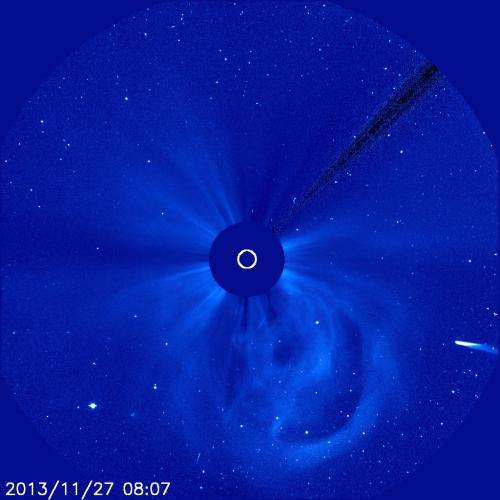Comet ISON streams toward the sun from the lower right in this image from the ESA/NASA Solar and Heliospheric Observatory mission, captured at 3:07 a.m. EST on Nov. 27, 2013. A cloud of solar material, called a coronal mass ejection, is seen under the sun. Credit: ESA/NASA/SOHO
As Comet ISON heads toward its closest approach to the sun—known as perihelion—on Nov. 28, 2013, scientists have been watching through many observatories to see if the comet has already broken up under the intense heat and gravitational forces of the sun. The comet is too far away to discern how many pieces it is in, so instead researchers carefully measure how bright it is, which can be used to infer its current state. Less light can sometimes mean that more of the material has boiled off and disappeared, perhaps pointing to a disintegrated comet. But also a disintegrating comet sometimes gives off more light, at least temporarily, so researchers look at the comet's pattern of behavior over the previous few days to work out what it may be doing.
Has Comet ISON broken up? It is still unclear.
At times observations have suggested ISON was getting dimmer and might already be in pieces. However, over Nov. 26-27, 2013, the comet once again brightened. In the early hours of Nov. 27, the comet appeared in the view of the European Space Agency/NASA mission the Solar and Heliospheric Observatory in the Large Angle and Spectrometric Coronagraph instrument. Coronagraphs block out the bright light of the sun in order to better see the dimmer solar atmosphere, the corona. In these images, the comet looks quite bright as it moves in from the lower right of the image. A giant cloud of solar material, called a coronal mass ejection or CME, is also seen in the images bursting off the bottom of the sun and heading out into space. It is as yet unclear if the CME is heading towards ISON but even if it does, it poses no real danger to the comet.
ISON enters the field of view of the joint ESA/NASA Solar and Heliospheric Observatory, or SOHO, spacecraft's C3 coronograph, where the brighter view of the sun itself is blocked to focus on the solar atmosphere, or corona. This video covers 17 hours beginning at 19:42 UT on Nov. 26, 2013. Credit: NASA SVS
If the comet has already broken up, it should disintegrate completely as it makes its slingshot around the sun. This would provide a great opportunity for scientists to see the insides of the comet, and better understand its composition—as such information holds clues about what material was present during the solar system's formation when this comet was born. However, it would likely mean no comet visible in the night sky in December. We'll only know for sure after the comet rounds the sun on Thanksgiving Day.
Provided by NASA's Goddard Space Flight Center
























